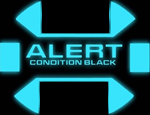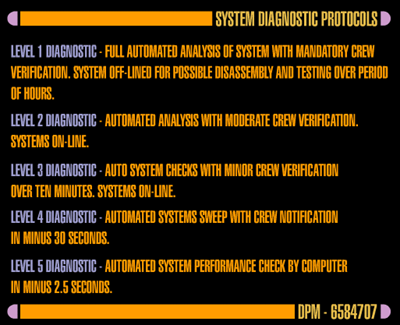Flight Operations
Created by Commodore Wilkan Targaryen on Sat Dec 21st, 2024 @ 1:20pm
Flight Operations
The mission of the Starship Enterprise is to explore the galaxy; however, the types of activities undertaken by the vessel consist of several subcategories of operations. Flight Operations are activities that directly relate to the operation of the Enterprise herself while Mission Operations consist of activities undertaken by the vessel's crew, with primary missions being coordinated by the Bridge and secondary missions being directly supervised by the individual departments aboard the ship.
Mission Types
The Century Class is a Multi-Mission Exploratory vessel designed to perform a variety of mission roles both independently and concurrently to others. Among the roles that the Enterprise performs include:
- Diplomatic Operations: Due to its role as a frontline exploratory vessel, the Enterprise is essentially a mobile Federation Embassy and can undertake diplomatic assignments including first contact.
- Emergency Response: The Enterprise has been designed to be able to quickly respond to a crisis situation (both planetary and spaceborne) and incorporates appropriate personnel and resources to successfully respond.
- Exploratory Operations: Members of the Century Class have been designed to undertake long-term missions of deep space exploration, charting and exploring unknown regions of space.
- Flagship: Century Class Starships include all the equipment necessary to lead other ships on long-term missions, whether they be a mission of discovery, first contact, survey, or tactical operations.
- Survey Operations: Normally handled by a dedicated science vessel, the Enterprise has been outfitted to undertake long-term scientific operations to investigate strange new worlds and unusual phenomenon.
- Tactical Operations: While not a warship, the members of the Century Class are equipped for police and military actions on behalf of the Federation.
- Technical Testing: Outfitted with bleeding-edge technologies, the Enterprise is able to test observe the new equipment in operation, identifying flaws and overcoming any issues.
Operating Modes
Based on the conditions and circumstances existing at any given moment, a starship will assume one of several operating modes which dictate which systems become (or remain) active, the preparations made by the ship’s personnel, and so forth. The following brief descriptions indicate what each mode involves, and the Power costs involved.Operating Modes | ||
 |
Also known as Reduced Power mode, Condition Gray is used to conserve power or when the ship is docked at a Starbase or other support outpost. Shields and weapons are shutdown and some systems are operated at minimum levels. The Warp Core is deactivated, unless the ship will be traveling at low Warp speeds. All active sensor sweeps and communications outside the ship are strictly forbidden. | |
 |
Used during non-crisis situations, Condition Green is the standard operating mode of the Enterprise and is sometimes called Cruise Mode. At shift change Level 4 diagnostics are completed on all primary and tactical systems and at least one major power system is operational. Weapons are unpowered. Long-Range sensors and the Navigational Deflector are online and active with a shuttlecraft ready for deployment. | |
 |
Condition Blue (or Blue Alert) is an alert status on Starfleet vessels used during exceptional situations including environmental system failure, landing, and main power failure. Level 4 diagnostics run on all primary and tactical systems and power and propulsion systems are brought to full operating condition. | |
 |
An elevated operating mode, Condition Yellow (or Yellow Alert) is used to prepare for a potential crisis. Power and propulsion systems brought to full power and auxiliary power is brought to standby status. Weapons are powered and brought to standby status and Deflector Shields are, normally, activated. Level 4 Diagnostics are initiated on all primary and tactical systems. | |
 |
Also known as Red Alert, Condition Red is an actual state of emergency or combat. Shields and weapons are brought online and Level 4 diagnostics run on all primary and tactical systems at five-minute intervals. Anti-Intruder and Escape Systems are brought to standby with isolation doors and forcefields engaged around critical areas. Sensors are brought to full operational status and Shuttlebays are brought to 30 launch readiness. | |
 |
Condition Black, or Black Alert, is a specialized alert status that is used on vessels equipped with experimental propulsion systems. Level 4 diagnostics are run on all engine systems at five-minute intervals. Any shipboard activity that is not essential to shipboard operations are cancelled and all non-essential systems run at half power or may only be used with permission. | |
Fortress Mode
Developed for the Typhon Class Escort Carrier shortly after the Dominion War, Fortress Mode is a specialized operating mode intended to transform a starship from a mobile exploratory vessel into a stationary tactical assault base.Deployed on only a handful of starship classes since its inception, Fortress Mode reinforces the vessel to withstand more intense combat than it would normally be able to survive. When first engaged armor plating, reinforced by stronger structural integrity fields, slides into place to protect vital systems from attack. All nonessential activities are cancelled and nonessential systems deactivated, with their energies rerouted to support offensive and defensive systems. While most of this energy is transferred to strengthen the Deflector Shields, additional energy is used to bring the Point Defense Phaser Cannons online. These weapon turrets are designed to automatically target incoming projectiles or small craft within their firing arc and destroy them before they can damage the Enterprise, or they will target larger opponents if no other targets of opportunity are available.
While Fortress Mode makes the Enterprise into an effective weapon of war, its usage does not guarantee success in a battle and is intended as a last-ditch defensive option when the ship is faced with overwhelming odds. As the Enterprise is immobile during Fortress Mode due to the rerouting of power to the tactical systems, it is possible that the ship could be overwhelmed and surrounded by its attackers. In an effort to escape from danger if the Enterprise loses the fight, energy is transferred to Impulse Capacitance Cells located within the Impulse Engines within the first moments of combat. Once Fortress Mode is deactivated the Impulse Engines are the first propulsion system brought online, with the Impulse Capacitance Cells power being transferred directly into the Impulse Driver Coils to generate a temporary burst of speed, even if the engines are otherwise nonfunctional.
Planetary Landing
Despite its size and complexity, the Century Class has been designed with the ability to land on the surface of a planet and return to orbit without outside assistance. While the Enterprise is an advanced starship, the landing process is not considered a routine operation and is to only be performed in an emergency situation where the vessel has no other option but to land to accomplish its mission objectives. Because of the rarity of this maneuver, few Starfleet Officers have ever performed the landing procedure in the field and their experience with the process is more academic than real world.Once the order was received from the Commanding Officer to land the vessel, the landing procedure would commence. While sensor scans of the surface of a planet would initiate to find a suitable landing zone for the Enterprise to touchdown the ship would concurrently switch to Blue Alert in preparation for landing. Engineering would deactivate the faster-than-light engines of the ship and vent Warp Plasma from the nacelles to prevent their reacting to the atmosphere of the planet. The Helmsman would set RCS Thrusters to atmospheric mode and place the ship's landing gear on standby to prepare for deployment. In the final stages of preparation, the Inertial Dampening Fields and Structural Integrity would be brought to maximum power to prepare for descent.
With their landing site selected and initial preparations complete, the Helmsman would begin descent into the planet's atmosphere using a standard glide trajectory. Due to atmospheric interference, minor course corrections were commonly made by the Helmsman and adjustments to the ship's structural integrity and inertial dampeners were conducted by the Operations Officers. Science Officers would closely monitor the descent trajectory for threats within the atmosphere that could potentially damage the vessel and share these results with the helm.
Once the planet’s surface was visible final scans of the landing site were completed and any course corrections completed. The ship's eight landing struts were deployed from the Engineering Hull by the Helmsman during the final approach to the landing zone. Once fully extended, the landing gear would lock into place shortly prior to touchdown. Ops would adjust the Structural Integrity Field to match the planet’s gravity. Inertial Dampeners would attempt to compensate for touchdown, but often personnel would still feel a slight shudder when the ship landed. Once complete, Engineering would disengage the engines and personnel could disembark to the planet.
When the ship was ready to return to orbit the same steps would occur, but in reverse order.
System Diagnostic Protocols
 While many of the systems aboard the Starship Enterprise are highly automated, each component part of the starship will need maintenance from time to time to ensure that the system is operating at peak efficiency. To ensure effective operations or to resolve a potential malfunction, the Damage Control and other Engineering Teams can engage the System Diagnostic Mode to try to locate any errors in the ship's systems.
While many of the systems aboard the Starship Enterprise are highly automated, each component part of the starship will need maintenance from time to time to ensure that the system is operating at peak efficiency. To ensure effective operations or to resolve a potential malfunction, the Damage Control and other Engineering Teams can engage the System Diagnostic Mode to try to locate any errors in the ship's systems. A specialized form of sensor scan, Systems Diagnostics will analyze a system in an effort to locate malfunctions in the system hardware or to locate any fragmentation in an operating system. Currently, Starfleet utilizes five different diagnostic scans to ensure system stability and efficiency that are rated based upon the level of involvement by the computer systems and technicians. In many instances the diagnostic mode will be able to repair an issue quickly without direct interaction by a member of the engineering team.
System Diagnostics | ||
| 6+ Hours | The most comprehensive and laborious diagnostic test available onboard the Enterprise, a Level 1 Diagnostic involves extensive analysis of the system and onsite verification of all of the results to be physically completed by the Engineering Team. Because of the intensive investigation needing to be completed the impacted system is shut down during the diagnostic protocol and not reactivated until the diagnostic is completed, except for testing. | |
| 1 - 6 Hours | Less intensive and laborious than a Level 1 Diagnostic, a Level 2 Diagnostic involves extensive analysis of the system but with moderate onsite verification of the results. In some instances the impacted system is shut down during the diagnostic protocol, but this is not always required. | |
| 10 Minutes | Similar to a Level 1 and 2 Diagnostic, a Level 3 Diagnostic involves extensive analysis of the system but minor onsite verification of the results. | |
| 30 Seconds | Highly automated, a Level 4 Diagnostic is used to verify that a system is experiencing no malfunctions. Similar to a Level 5 Diagnostic, the Level 4 Diagnostic simply features more intensive diagnostic batteries over its Level 5 counterpart and requires no onsite verification. | |
| 2 Seconds | Highly automated, a Level 5 Diagnostic is used to verify system performance at least once a day. | |
Categories: Operations | Command